Wujing zongyao 武經總要 "Compendium of important matters from the military classics" is an important book on the military system and military administration from the Northern Song period 北宋 (960-1126). It was written by Zeng Gongliang 曾公亮 (999-1078), courtesy name Mingzhong 明仲, style Lezheng 樂正, and Ding Du 丁度 (fl. 1045), and submitted to the throne in 1045. It consists of 40 juan arranged in two collections (Qianji 前集 and Houji 後集). The title of the book is not quite exact because the Wujing zongyao does not only quote from the ancient classics but provides a vast amount of information on the ancient and contemporary military systems.
In the first collection (Qianji), the military system (zhidu 制度) from ancient times to the Song is explained in 15 juan, describing in detail the art of war, battle tactics, training methods, battle formations, the use of infantry and cavalry units, defence and siege, warfare with fire and water, reconnaissance and espionage, the garrison system, as well as weapons of each kind. In the following 5 juan, the ancient and contemporary systems of border defence (bianfang 邊防) are described, with many informations on the garrison system in each circuit of China, as well as the military situation in the neighbouring empires of Liao 遼 (907-1125) and Western Xia 西夏 (1038-1227).
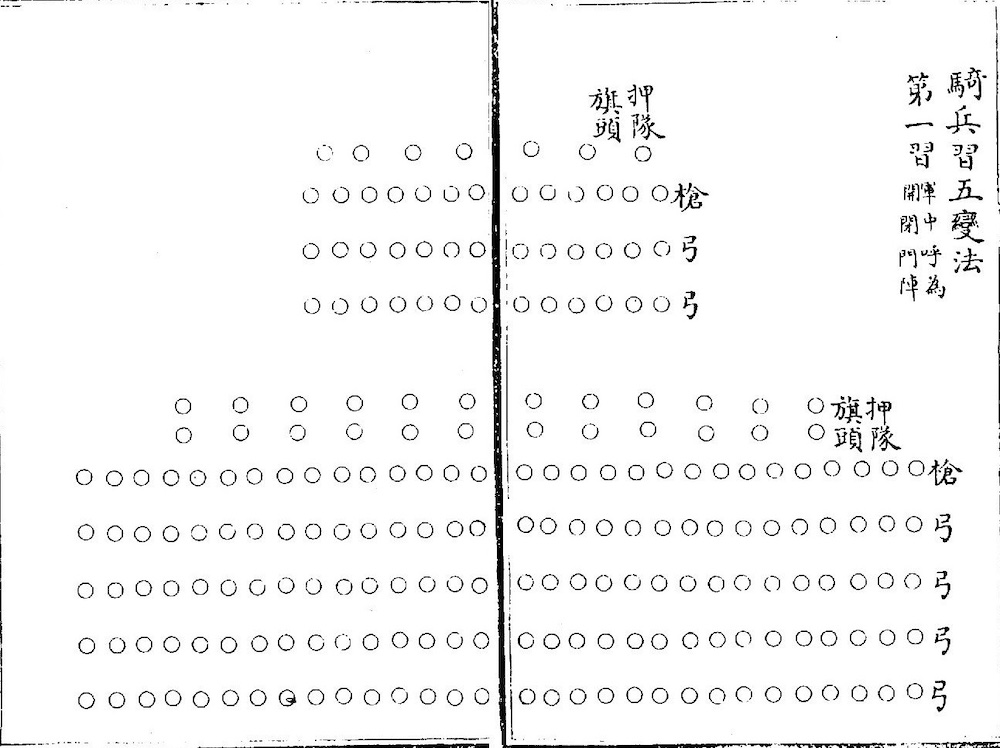 |
|
Five formations trained by cavalry units (qibing xi wu bian fa 騎兵習五變法), 1st part. Each of the two blocks (larger, smaller) was headed by a line of banner bearers. Behind them followed riders with polearms (qiang 槍), while the main part of the two bodies consisted of archers (gong 弓). Wujing zongyao 2: 24b-25a. Siku quanshu 四庫全書 edition. |
|
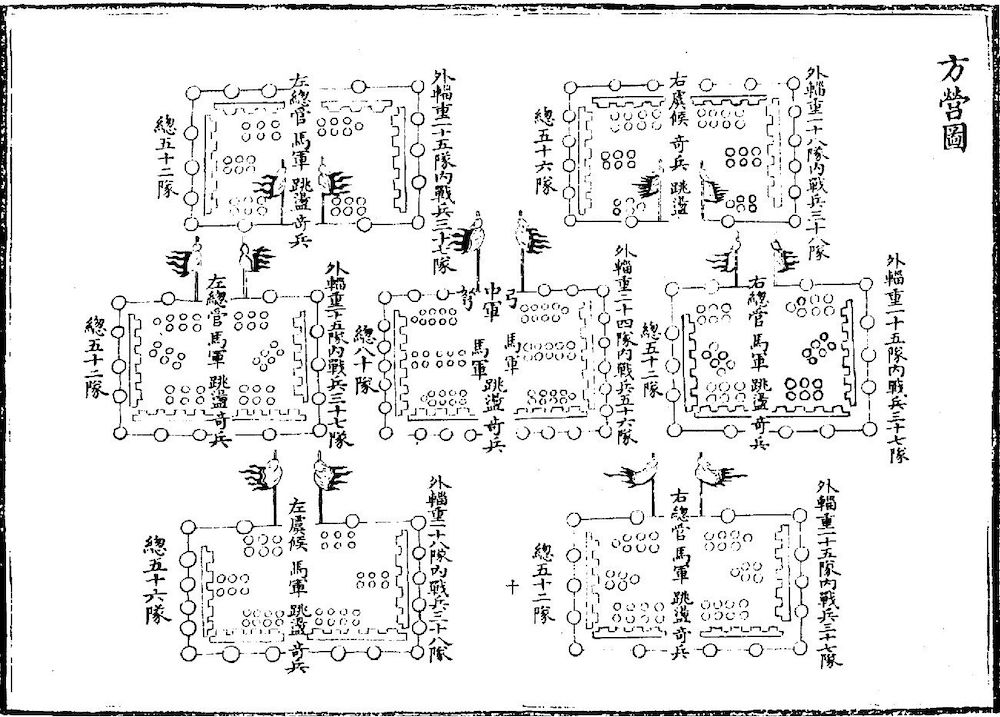 |
|
Rectangular encampment (fangying 方營), divided into seven blocks, each of which was surrounded by carts. Wujing zongyao 6: 10. |
|
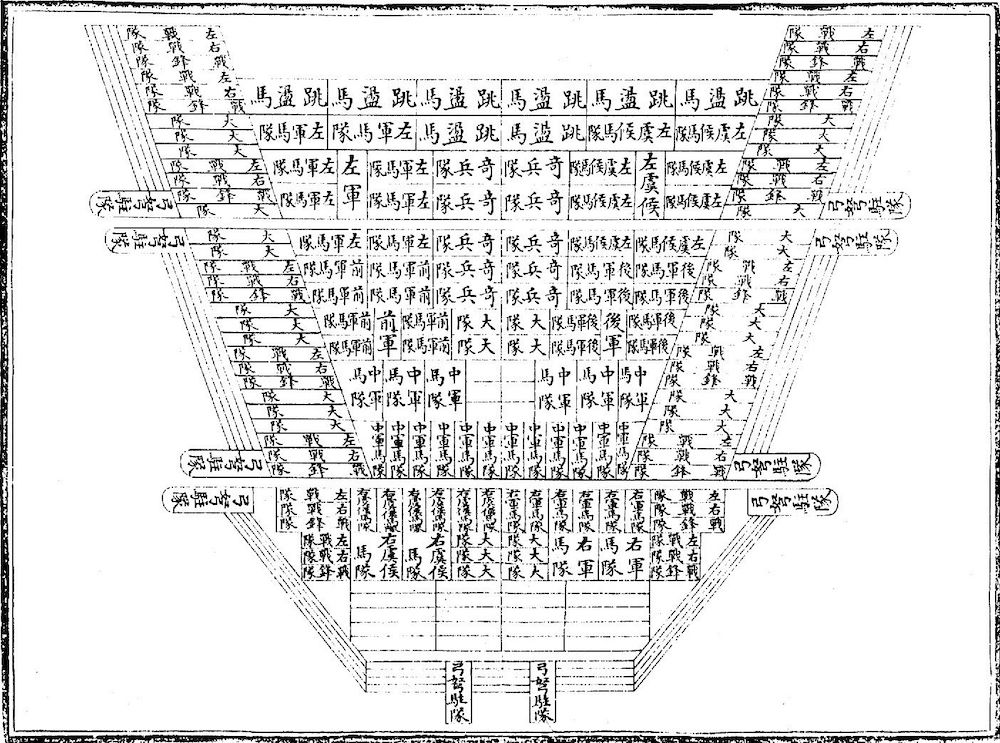 |
|
Large battle formation called "travelling goose" (yan xing zhen 雁行陣). Wujing zongyao 7: 21. |
|
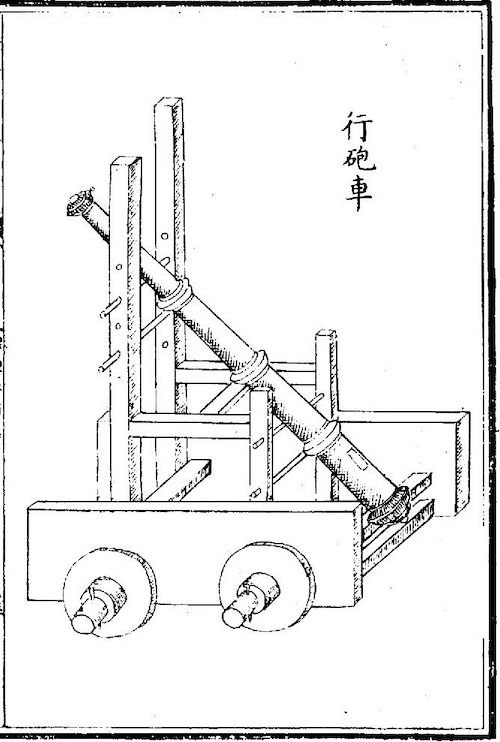 |
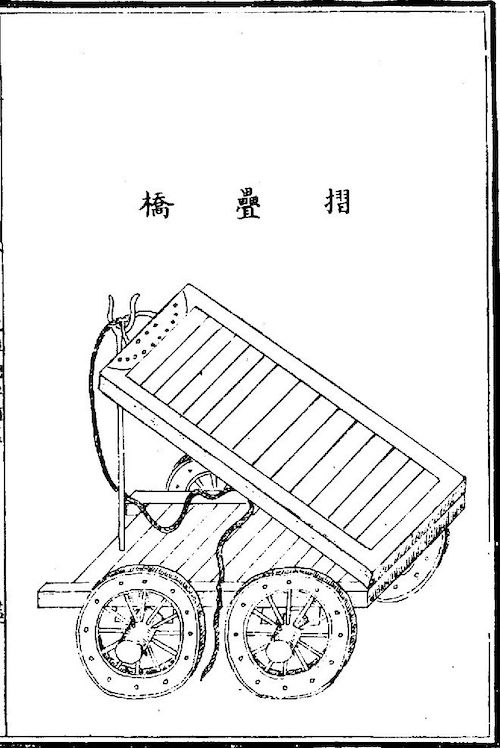 |
Moveable cannon (xingpaoche 行跑車) and mobile folding bridge (zhedieqiao 摺疊橋). Wujing zongyao 10: 13a, 15a. |
|
In the second collection (Houji) important counsels from ancient times (gushi 故事) are described in an encyclopaedic style, using ancient sources, in 15 juan. In the last 5 juan, the relationship between climate, weather, the cosmos, astrology and warfare is described (zhanhou 占候), which is very interesting for the history of thought.
The part of the book which attracted scholarship the most is that about firearms in which a whole series of weapons are described used at that time. It is very important for the history of military technology.
The Wujing zongyao is a very important source for the change from a society, in which the military had a very high position, to a state in which the civilian part and the central government prevailed over local military commanders. Because of this change in the perception of governance, generals had lost a lot of independence. They were mere execution tools of the emperor's commands, and not any more personalities of their own. Autonomous decision of a general on the battlefield was more difficult than before.
The concepts of the ancient military classics are nevertheless still adhered to. Exercise, command and obeisance are important necessities without which no army could win. The officers, on the other hand, had to be intelligent and capable to lead the troops to victory.
Of a print from the Ming period 明 (1368-1644), only the first part is preserved. The imperial series Siku quanshu 四庫全書 contains the first and the second part.
前集 First part |
|
| 制度 Military system | |
|---|---|
| 1 | 選將 Selection of generals, 將職 positions of generals, 軍制 military organisation, 料兵 use of soldiers, 選鋒 selection of crack troops, 選能 selection of competent troops |
| 2 | 講武 Lecturing on war, 教例 instruction the ranks, 教騎 instruction on cavalry, 旗例 signals for the ranks, 習勒進止常法 standard commands, 教平原兵 instruction on [operation] in flat territory, 教歩兵 instruction on infantry, 教騎兵鼓角金鉦(教塲等圖) instruction on signals for cavalry (with illustrations on the training ground, etc.), 教法 instruction methods, 教條十六事三令五(申附) various paragraphs on instructions, 打圍草教法并圖 rough instructions of encirclement with illustrations, 日閲法 day review, 騎兵習五變圖 training the four transformations of cavalry formations with illustrations, 歩兵習四變圖 training the four transformations of infantry formations with illustrations, 教弩法并圖 instructions in the crossbow, with illustrations, 教弓法 instructions in archery |
| 3 | 叙戰上中下 Battle descriptions, 抽隊 protection of the flanks, 軍爭 struggle for victory, 以寡擊衆 attacking stronger enemy units, 捉生 war captives |
| 4 | 用車 Use of chariots, 用騎 use of cavalry, 奇兵 unorthodox formations, 料敵將 use of the enemy’s leaders, 察敵形 inspection of inimical formations |
| 5 | 軍行次第并圖, 行為方陣法并圖, 禁諠 silence, 度險 passing critical spots, 出隘 leaving one’s territory, 齎糧 food supply, 斥堠聽望 observation and reconnaissance, 探旗 recognising inimical units, 探馬 scouts, 遞舗 military couriers, 烽火 fire signals, 行烽 transmission by fire signal, 軍祭 military sacrifices, 軍誓 military speeches, 定惑 settling doubts |
| 6 | 下營法 Methods of erecting a camp, 營法并三圖 rules for camps, with illustrations, 諸家軍營九説 nine explanations for all garrisons, 下營擇地法 selecting ground for encampments, 緣營雜制 various arrangements for camps, 警備 the watch, 備夜戰法 fighting by night, 立號 establishing orders, 定舖 establishing watch posts, 持更 keeping the watch, 廵探 patrols, 漏刻 time measuring, 防毒 precautions against poison, 尋水泉 searching for water, 飬病 tending the sick, 征馬 war with horses |
| 7-8 | 陣法總說 General explanation of battle formations and tactics |
| 9 | 九地 The nine types of ground, 六形 the six shapes, 雜叙戰地 various descriptions on battle ground, 土俗 distinct character of local ground |
| 10 | 攻城法 Methods of assailing cities |
| 11 | 水攻并圖 Attack by water, with illustrations, 水戰(濟水附)并圖 battle on water (River Ji), with illustrations, 火攻 attack by fire |
| 12 | 守城并器具(圖附) Defence of cities, and corresponding tools (with illustrations) |
| 13 | 器圖 Illustrations of objects |
| 14 | 賞格 Rules for reward, 罰條 paragraphs on punishment |
| 15 | 行軍約束 Discipline during marches, 符契 tallies and orders, 傳信牌 forwarding messages, 字驗 registration of messages, 間諜 spies, 鄉導 local guides |
| 邊防 Border Defence | |
| 16AB | 河北路 Hebei Route, 定州路 Dingzhou Route, 高陽關路 Route of Gaoyang Pass, 真定府路 Route of Zhengding Prefecture |
| 17 | 河東路 Hedong Route, 麟府路 Linfu Route, 廢壘 abandoned fortresses |
| 18AB | 陜西路 Shaanxi Route, 鄜延丹坊保安軍路 Routes of Linzhou, Yanzhou, Danzhou, Dangzhou, and the military prefecture of Bao'an, 邠寧環慶路 Routes of Binzhou, Ningzhou, Huanzhou, and Qingzhou, 涇原儀渭鎮戎徳順軍路 Routes of Jingzhou, Yuanzhou, Yizhou, Weizhou, and the military prefectures of Zhenrong and Deshun, 秦隴鳯翔階成州路 Routes of Qinzhou, Longzhou, Fengxiang, Jiezhou, and Chengzhou |
| 19 | 益利路益州 Yi-Li Route, Yizhou Prefecture (今改為成都路 Chengdu Route), 梓䕫路梓州 Zi-Kui Route, Zizhou Prefecture (重和元年改為潼川府路 Route of Tongchuan Prefecture) |
| 20 | 荆湖北路 Route of Jinghu-North, 荆湖南路 Route of Jinghu-South, 廣南東路Route of Guangnan-East, 廣南西路 Route of Guangnan-West |
後集 Second part |
|
| 故事 Evidence from history | |
| 1 | 上兵伐謀 Supreme strategy of attack by planning, 不戰屈人之師 Subduing an [enemy's] army without a battle, 用間 use of spies, 用謀 use of counsels, 覘國 spying out other states, 用敵人以為謀主 use the enemy as your strategic advisor, 縱生口 Let captured people live |
| 2 | 明賞罰 Clarify reward and punishment, 軍政不一必敗 an army not unified will be defeated, 軍無政令必敗 an army without order will be defeated, 將帥和必有功 commanders in harmony will have success, 將帥不和必敗 commanders not unified will suffer defeat, 法貴不犯 rules are precious if not broken, 兵道尚嚴 the way of the military values strict discipline, 臨敵不顧親 in the face of the enemy, do not consider personal ties, 仁愛 kindness and love, 士卒同甘苦 officers and soldiers are unified in good and bad times, 親受矢石 endure hardships and danger personally, 撫士 support your soldiers, 得士心 gain the heart of your troops, 得士死力 gain your soldiers' utmost commitment, 貴先見 value foresight, 知己知彼 know yourself and know your enemy, 料敵主將 use the enemy's commanders, 料敵制勝 use the enemy's organisation to achieve victory, 料敵形勝 use the enemy's formation to gain victory |
| 3 | 方略 Strategy, 權奇 strategic use of unconventional methods, 臨事制宜 dealing with matters as based on circumstances, 詭道 ways of deception, 奇計 extraordinary plans |
| 4 | 將貴輕財 A general is worth more than money, 將貪必敗 corrupt generals will be defeated, 臨敵易將 exchanging the general in face of the enemy, 將驕必敗 arrogant generals will fail, 矜伐致敗 arrogance and boasting leads to defeat, 不矜伐 no arrogance, 將師自表異致敗 commanders striving for promotion invite defeat, 將帥自表異以奪敵心 commanders demonstrating their uniqueness to demoralise the enemy, 均服 sameness of uniforms [for all ranks] , 隱語 secret language (codewords), 先鋒後殿 vanguard and rearguard, 擊其後 attacking the rearguard, 退師 retreat |
| 5 | 出奇 Deploy surprise [attacks], 伏兵 hidden forces (ambush), 多方以誤之 mislead [the enemy] from many directions, 聲言欲退誘敵破之 declare your intention to retreat to lure the enemy [into a trap] and destroy them, 聲言怠敵取之 declare the intention to slacken, and then take advantage of the enemy, 稱降及和因懈敗之 claim surrender and offer peace to cause complacency, leading to [the enemy's] defeat, 卑辭怠敵取之 use humble words to lull the enemy [into complacency] and then take advantage, 甘言怠敵以擊之 use sweet words to lull the enemy [into complacency] and then strike, 擣虛 strike at the weak point, 擊東南備西北 attack the southeast but prepare for [a real attack from] the northwest, 聲言擊東其實擊西 pretend to attack the east but actually attack the west, 示形在彼而攻於此 show yourself in one place, but attack from another |
| 6 | 張大聲勢 Amplify your sounds and strengths [by deception], 先聲後實 make [faint] noises first before delivering a real [attack], 疑兵 confuse [your enemy's] troops, 察虛聲 observed void (deceptive) signals, 避實擊虚 avoid the solid but attack the void, 以寡擊衆 attacking a stronger enemy with smaller forces, 攻其必救 attack where [the enemy will send his] rescue troops to, 夜擊 nocturnal attack, 潛兵襲營 hiding troops to attack a camp, 横擊 flanking attacks, 掩襲 concealed attacks, 偽退掩襲 false retreat to cover an attack |
| 7 | 持重 Act with restraint, 輕敵必敗 underestimating the enemy will lead to defeat, 戒輕舉 avoid hasty actions, 堅壁挫銳 strengthen your walls and blunt the enemy's sharpness, 避銳 evade points of strength, 以逸待勞 rest while waiting for the enemy to tire, 矯情安衆 pretend [positive] emotions to reassure your troops, 軍中虚偽 deception within the army, 尅敵安衆心 defeat the enemy to stabilize the hearts of your troops, 辨詐偽 distinguish between deception and falsity |
| 8 | 御士推誠 Command your officers to incite dedication and sincerity, 與敵推誠 Extend dedication and sincerity towards the enemy, 以恩信結敵人 bind the enemy with kindness and trust, 知人 know your men, 善用人 good use of men, 解仇用人 resolve enmity by using personalities, 使過 admit wrongdoing, 示信 display trustworthiness, 示義 display righteousness, 以義感人 move others with righteousness, 激怒士心 stir up your troops' emotions |
| 9 | 絶藝 Unique skills, 挑戰 choose the battlefield, 勢宜决戰 circumstances are profitable for decisive battle, 臨危决戰 in the face of danger make a decisive battle, 戮力必勝 unite your forces and victory is certain, 驍勇敢前 be brave and advance boldly, 陷陣摧堅 penetrate the formations and destroy the strongholds, 表裏夾攻 attack from both the front and the rear, 乘勝破敵 take advantage of a victory to break the enemy, 乘機破敵 take advantage of opportunities to break the enemy, 乘風雨破敵 take advantage of wind and rain to break the enemy, 散衆 scatter the [enemy's] forces |
| 10 | 兵貴有繼兵無繼(必敗附) Troops are valuable when they are sustained – an army without reinforcements is doomed (app. Inevitable defeat), 兵多宜分軍相繼 when the troops are many, they should be divided, and the army should advance in succession, 救兵 rescuing troops, 力少分兵必敗 dividing troops when you have few forces will surely lead to defeat, 分兵勢破之 divide [the enemy's] forces to break their momentum, 上速 rapid advance, 示緩攻敵有(緩急附) display of slow movement to attack the enemy's [slowness] (app. Slow and fast movements), 示弱 display of weakness, 示彊 display of strength, 示閑暇 display idleness, 設詐誤敵此條正(文闕) set a deception to mislead the enemy, and then strike at the right moment (chapter missing), 素教 simple instructions, 素備 basic readiness, 先設備取勝戒不(備附) prepare in advance to achieve victory, and be cautious not to neglect anything (app. Preparedness) |
| 11 | 新集可擊擊未(集附) Strike an enemy who is newly assembled or not fully formed (app. Assembling troops), 半濟可擊 strike an enemy who is [only] partially accomplished, 飢渴可擊 strike a starving enemy, 心怖可擊 strike a frightened enemy, 奔走可擊 strike a fleeing enemy, 氣衰可擊 strike an enemy with low energies, 糧盡可擊糧道不繼(必遁附) strike the enemy when their supply lines are cut (app. When [the enemy] must retreat), 不得地利可擊 strike an enemy who is not able to profit from the terrain, 天時不順可擊 strike when time and weather are unfavourable, 不暇可擊 strike an enemy who has no time to react, 不戒可擊 strike the enemy when they are not vigilant, 將離部伍可擊 when a commander is separated from his troops, they can be attacked, 撓亂可擊 strike the enemy when they are in turmoil, 陣久力疲必敗 a formation or battle hold for too long will lead to exhaustion and inevitable defeat, 攻不整 strike when the [enemy] is still in disorder, 敵無固志可擊 when the enemy lacks firm resolve, he can be attacked, 擊不備 attack an unprepared enemy, 出不意 appear unexpectedly, 大陣動可敗 a greater formation, when in motion, can be defeated, 擊未成列 strike before the enemy is arrayed |
| 12 | 餌兵勿食(防毒附) Don't eat [the enemy's] bait (app. Caution against poison), 圍敵勿周 when surrounding the enemy, don't close the circle, 窮冦勿廹 do no corner a desperate enemy, 高陵勿向 do not climb high ground, 佯北勿從 do not pursue a feigned retreat, 察敵進止 observe the enemy's advances and stops, 察敵逃遁 observe the enemy's flight and evasion, 歸師勿遏 do not obstruct a retreating enemy, 死地勿攻 to not attack on deadly terrain, 立奇功 establish remarkable achievements, 軍師伐國若中路遇大城須下而過 when a military strategist attacks a country and encounters a large city on the main road they must refrain from fighting and pass by, 舍小圖大 give up the small to pursue the large, 師不襲遠 do not attack at great distance, 軍勝重掠伏襲必敗 an army that wins through excessive plundering and surprise attacks will inevitably be defeated, 擊歸墮 strike retreating forces to cause their downfall, 地有所不爭 some terrain is not to be fight over |
| 13 | 察敵降料降詐(降附) Examine the enemy's resources and recognise his deception (app. Surrendering), 招降 win troops by offering them fair treatment if they surrender, 諭以禍福 give orders with regard to fortune and misfortune, 縱舍 release and abandon, 占候 divination of time, 至誠獲神助 with supreme sincerity one gains divine assistance, 推人事破灾異 analyze human actions to resolve disasters and anomalies, 假托安衆 feign to reassure the masses, 下營擇地 for an encampment select the ground carefully, 據險 occupy critical passes, 先據要地 first occupy strategic places, 據水草 occupy his grazing grounds and water supply, 絶水泉 cut off his waters, 據倉廪 occupy his granaries, 斷敵糧道 cut off the enemy's supply route, 伏歸路敗之 ambush the enemy's return path to defeat him |
| 14 | 水戰 Naval warfare, 濟水 crossing a river, 斷船路 cutting off shipping routes, 引水灌城 deviation of water to flood cities, 擁水誤敵 manipulating water to trick the enemy, 火攻 attack by fire, 用車 use of chariots, 用騎 use of cavalry, 遊騎 mobile cavalry |
| 15 | 修城柵 Building walls and fences, 攻城 attack on cities, 守城 defence of cities, 屯田 agro-colonies, 讓功 ceding merit, 辭賞 declining reward |
| 占候 Divination | |
| 16 | 天占 Divination by heaven, 地占 by the earth, 五行占 by the Five Agents, 太陽占 by the Sun, 太陰占 by the moon, 陵犯雜占 various deviations |
| 17 | 日辰占 Day and hour divination, 五星 divination by the five planets, 二十八宿次舍 the progress of the 28 constellations, 諸星占 various stars, 星變 changes of stars, 風角 wind directions |
| 18 | 雲氣 Divination by clouds and qi, 氣象雜占 various celestial phenomena, 軍行災異雜占 various disasters and strange occurrences for marches, 太乙 taiyi divination |
| 19AB | 太乙定主客勝負陰局立成 The Yin section’s establishment of the realisation of the determination of host and guest, victory and defeat by taiyi divination |
| 20 | 占候五: 六壬 liuren divination, 遁甲 dunjia divination |